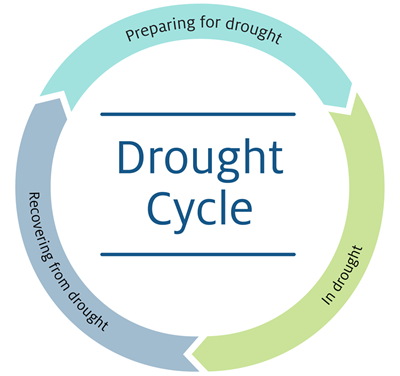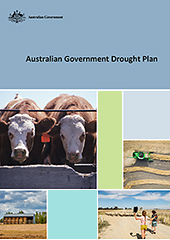Drought is a recurring feature of the Australian landscape. It is forecast to become more frequent, severe and longer lasting in many regions as the climate changes.
The Australian Government is working with farmers, rural communities, the states and territories, and the agriculture, finance and not-for-profit sectors to build Australia’s capacity to withstand drought.
We all have a role to play in drought.
Stay up to date and have your say on drought-related policies and programs.
Need help?
Check current drought and rural support we provide.
Find services and support near you from governments, charities and other organisations.
Call the Farmer Assistance Hotline on 132 316.
What we are doing
As of December 2024
Future Drought Fund (investing $100 million a year to build drought resilience)
- 8 drought hubs with over 125 on-ground projects
- Over 180 other drought resilience projects funded
- Over 46,000 farmers engaged in business and risk management training
- 289 organisations and more than 1,000 people supported to build community drought resilience
- Around 70 regions undertaking drought resilience planning
Other Australian Government programs
- Almost 2,891 farmers and their partners currently on Farm Household Allowance
- 41,337 farm management deposit accounts
- 3,247 concessional loans settled for farm and related small businesses
Our Drought Plan
Australian Government Drought Plan
The Drought Plan explains the Australian Government’s drought policy and how we support farming businesses and communities to prepare for, manage through and recover from drought.
Our drought policy aims to:
- build the drought resilience of farming businesses by enabling preparedness, risk management and financial self-reliance
- ensure an appropriate safety net is always available to those experiencing hardship
- encourage stakeholders to work together to address the challenges of drought.
The Drought Plan is informed by a review of the previous one, public consultation and stakeholder discussions. It builds on the long history of drought policy in Australia. It also helps deliver on the Australian Government’s commitments under the National Drought Agreement.
How the plan makes a difference
Find out what the plan means for farming businesses and communities, and the organisations that support them.
The Drought Plan shows how we deliver on our commitments under the National Drought Agreement.
The National Drought Agreement outlines the roles and responsibilities of the Australian, state and territory governments before, during and after drought.
The Australian Government will:
- run the Future Drought Fund (FDF)
- $519.1 million over 8 years
- deliver a household support payment for farming families
- Farm Household Allowance
- provide incentives for farmers to manage risk
- Farm Management Deposit
- other primary producer concessions
- RIC loans
- maintain national drought and climate information
- Bureau of Meteorology
- My Climate View
State and territory governments will:
- take the lead on drought policies and programs in their jurisdictions
- help design and deliver joint programs under the Future Drought Fund
- manage animal welfare and natural resource management issues during drought.
All governments will:
- collaborate on drought-related policies and programs, so they align with the agreement’s principles, improve the quality of support, and avoid unnecessary duplication, adverse impacts or burdens on applicants.
- build the capacity of farmers and rural communities to manage and withstand drought
- coordinate and share information on assistance to prepare for, respond to and recover from drought
- provide access to the Rural Financial Counselling Service
- support the health and wellbeing of drought-affected farmers and rural communities
- share information on current conditions and lessons learned from policy and program evaluations
The Australian Government is implementing a drought response framework to support its own awareness, preparedness, planning and response.
The framework regularly considers a range of qualitative and quantitative information to monitor drought conditions and impacts, which then supports proactive and informed government decision-making. This information includes:
- Data – for example, drawing from the Australian Agricultural Drought Indicators and the Bureau of Meteorology’s weather information and forecasts
- Feedback – regional and on-ground information through engagement with state and territory governments and numerous on-ground networks
Having improved situational awareness allows us to understand impacts from a range of perspectives, recognise pressure points, and identify other challenges and compounding hardships farmers may be experiencing.
The drought response framework supports the delivery of our ongoing support programs in dry conditions. It also assists the Australian Government in considering additional support needs if drought conditions and their effects are prolonged and severe.
Australian Agricultural Drought Indicators
Drought isn’t just about how much rain falls on a farm. The capacity to cope with dry conditions also depends on other factors. These include when rain falls, what the prevailing temperature, water balances, commodity prices and input costs are, and what financial and other reserves remain. Some of these factors are being integrated into Australian Agricultural Drought Indicators.
The indicators combine climate data and agricultural models to measure and forecast drought impacts on Australian agriculture. They feed Bureau of Meteorology seasonal forecasts into ABARES and CSIRO models to estimate rainfall deficiencies, soil moisture, pasture growth, crop yield and farm profit for 5km areas. This will result in monthly data about the extent, severity and timing of impacts as conditions dry.
The Drought Plan provides a clearer explanation of what we will and won’t do in drought.
The Australian Government:
- Will provide programs that help farmers prepare for drought and build their self-reliance
- Will provide a safety net for farmers who are in hardship
- Will make this assistance always available, so eligible farmers can access it when they need it
- Will work with state and territory governments to reduce gaps and duplications in assistance to farmers.
- Won’t make drought declarations
- Won’t provide support that:
- reduces the incentive to prepare for drought
- slows recovery from drought
- spreads the impacts of drought to areas not in drought
- favours a particular sector or disdvantages another
- distorts markets or undermines our trade obligations
- provides little public benefit
- duplicates what’s already on offer.
The Australian Government’s approach to supporting the agricultural sector to manage drought is built around a 3-stage cycle:

- Preparing – before drought, plan for drier times ahead
- In drought – during drought, action your plans to manage the impacts
- Recovering – after drought, consider lessons learned
The Drought Plan specifies the key drought-related programs that support farming businesses and communities across this cycle.
These include subsidised farm business planning and coaching, climate information, Farm Management Deposits and other tax concessions, low-cost loans, income support, rural financial counselling, and mental health and wellbeing services.
The Australian Government is there with you at each stage of the cycle.
By adapting to the drought cycle, Australian farming can remain profitable and sustainable. It can continue to protect our land and water, strengthen rural communities, secure the nation’s food supply and grow our economy.
Farmers and their communities look first for advice and help from people and organisations they trust and deal with regularly. We recognise that industry groups, First Nations peoples, financial and professional services sectors, research and Natural Resource Management organisations, charities and the not for profit sector all have a role to play in the drought cycle, alongside government.
We are providing more opportunities for stakeholders to keep abreast of drought policy and program news and to update us on conditions in their areas. We are also engaging with stakeholders to explore what is working well and what can be improved in our drought policies and programs. These opportunities range from the National Drought Forum and National Drought Network to regular reviews of specific programs.

